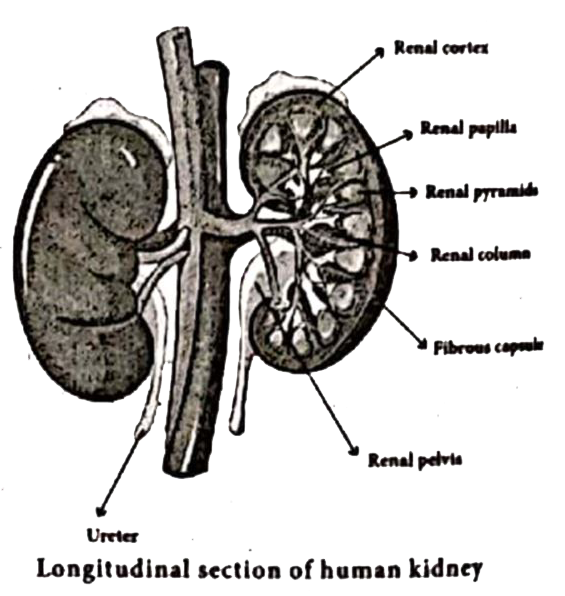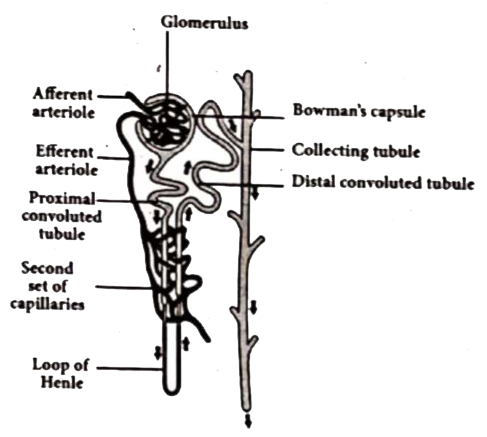Explain the structure of kidney and the steps involved in the formation of urine. Solution in Tamil

Kidneys are bean-shaped organs reddish brown in colour. The kidneys lie on either side of the vertebral column in the abdominal cavity attached to the dorsal body wall. The right kidney is placed lower than the left kidney as the liver takes up much space on the right side. Each kidney is about 11 cm long, 4 cm wide and 3 cm thick. The kidney is covered by a layer of fibrous connective tissue, the renal capsules, adipose capsule and a fibrous membrane.
Internally the kidney consists of an outer dark region, the cortex and an inner lighter region, the medulla. Both of these regions contain uriniferous tubules or nephrons. The medulla consists of multitubular conical masses called the medullary pyramids or renal pyramids whose bases are adjacent to cortex. On the inner concave side of each kidney, a notch called hilum is present through which blood vessels and nerves enter in and the urine leaves out.
Ureters are thin muscular tubes emerginng out from the hilum. Urine enters the ureter from the renal pelvis and is conducted along the ureter by peristaltic movements of its walls. The ureters carry urine from kidney to urinary bladder.
Urinary bladder is a sac-like structure, which lie in the pelvic cavity of the abdomen. It stores urine temporarily.
Urethra is a membranous tube, conducts urine to the exterior. The urethral sphincters keep the urethra closed and opens only at the time of micturition (urination).
Functions of kidney
1. Maintain the fluid and electrolytes balance in our body.
2. Regulate acid-base balance of blood.
3. Maintain the osmotic pressure in blood and tissues.
4. Help to retain the important plasma contituents like glucose and amino acids.
Structure of Nephron

Each kidney consists of more than one million nephrons. Nephrons or uriniferous tubules are structural and functional units of the kidneys. Each nephron consists of Renal corpuscle or Malphigian corpuscles and renal tubule. The renal corpuscle consists of a cup-shaped structure called Bowman.s capsule containing a bunch of capillaries called glomerulus. Blood enters the glomerular capillaries through afferent arterioles.
The Bowman.s capsule continues as the renal tubule which consists of three regions proximal convoluted tubule, U-shaped hair pin loop, the loop of Henle and the distal convoluted tubule. The distal convoluted tubule which opens into the collecting tubule. The nitrogenous wastes are drained into renal pelvis which leads to ureters and stored in the urinary bladder. Urine is expelled out through the urethrea.
Mechanism of Urine Formation
The process of urine formation includes the following three stages.
Glomerular filtration
Tubular reabsorption and
Tubular secretion
Glomerular filtration : Urine formation begins with the filtration of blood through epithelial walls of the glomerulus and Bowman.s capsule. The filtrate is called as the glomerular filtrate. Both essential and non-essential substances present in the blood are filtered.
Tubular reabsorption : The filtrate in the proximal tubule consists of essential substances such as glucose, amino acids, vitamins, sodium, potassium, bicarbonates and water that are reabsorbed into the blood by a process of selective reabsorption.
Tubular secretion : Substances such as H+ or K+ ions are secreted into the tubule. Certain substances like potassium and a large number of durgs like penicillin and aspirin are passed into the filtrate in the distal convoluted tubule. This tubular filtrate is finally known as urine, which is hypertonic in man. Finally the urine passes into collecting ducts to the pelvis and through the ureter into the urinary bladder by urethral peristalsis (waves of constriction in the ureters). The relaxation of sphineter muscles located at the opening of the urinary bladder into the urethra. When the urinary bladder is full the urine is expelled out through the urethra. This process is called micturition. A healthy person excretes one to two litres of urine per day.
Topper's Solved these Questions
- ORGAN SYSTEMS IN ANIMALSBook:FULL MARKSChapter:ORGAN SYSTEMS IN ANIMALSExercise:EXERCISE - ASSERTION AND REASON
Explore 2 Videos
- ORGAN SYSTEMS IN ANIMALSBook:FULL MARKSChapter:ORGAN SYSTEMS IN ANIMALSExercise:EXERCISE - HIGHER ORDER THINKING SKILLS
Explore 5 Videos
- ORGAN SYSTEMS IN ANIMALSBook:FULL MARKSChapter:ORGAN SYSTEMS IN ANIMALSExercise:EXERCISE - ANSWER BRIEFLY
Explore 6 Videos
- NUTRITION AND HEALTH Book:FULL MARKSChapter:NUTRITION AND HEALTH Exercise:ADDITIONAL QUESTIONS (V. Answer the following in detail.)
Explore 3 Videos
- ORGANIZATION OF TISSUES Book:FULL MARKSChapter:ORGANIZATION OF TISSUES Exercise:ADDITIONAL QUESTION LONG ANSWERS QUESTION
Explore 4 Videos
Similar Questions
Assertion : Urea is excreted out through the kidneys
Reason : Urea is a toxic substance.
View SolutionIf pepsin is lacking in gasric juic, then which event in the stomach will be affected ?
a. Digestion of starch into sugars.
b. Breaking of proteins into peptides.
c. Digestion of nucleic acids.
d. Breaking of fats into glycerols and fatty acids.
View SolutionHow is the small intestine designed to absorb digested food ?
View SolutionWhat is food spoilage? What are the factors responsible for food spoilage ?
View SolutionGive notes on: (i) squamous epithelium, (ii) cuboidal epithelium, (iii) columnar epithelium (iv) ciliated epithelium and (v) glandular epithelium.
View SolutionFirst step in urine formation is
View SolutionHypertonic urine formation is a characteristic of kidneys of
View SolutionDescribe the process of urine formation in kidneys.
View SolutionIn the kidney , the formation of urine involve the following processes arranged as
View SolutionHow many stages are involved in the formation of urine ?
View Solutionवृक्कों में मूत्र निर्माण की प्रक्रिया का वर्णन कीजिए।
View Solutionवृक्कों में मूत्र निर्माण की प्रक्रिया का वर्णन कीजिए।
View Solutionమూత్రం ఏర్పడే విధానం లో దశలు ఏవి?
View SolutionList two major steps involved in the formation of urine and state in bried their functions.
View SolutionDescribe the process of urine formation in kidneys.
View Solution

